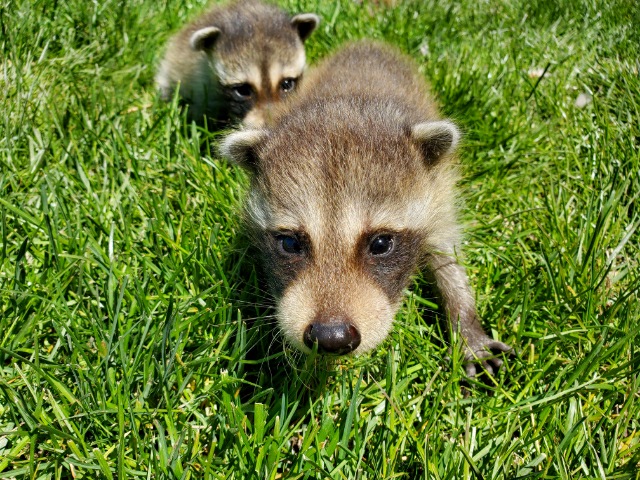Raccoons are often likened to bandits and burglars. This is partly because of their activities, such as rooting through garbage and “breaking and entering” into human homes, requiring wildlife control in Newmarket. The raccoon’s roguish reputation is also because of the black markings around its eyes that resemble a mask. Have you ever wondered why raccoons have masks? Keep reading to find out more about this distinctive feature.
Are Raccoons Born With Masks?
Raccoon babies, known as kits, aren’t born with visible masks. The pattern is present from birth, but when the raccoons are first born, the markings are so light-coloured that they blend in with the rest of the fur. As the babies mature, the markings gradually darken. When the kits are about 2-1/2 months old the masks should be dark enough to be discernible. This is about the same time that the kits are old enough to leave the nest, so if you see baby raccoons out in the wild, you may notice that they have masks. If you find raccoon kits in your home, you may be able to estimate their age based on how visible their masks are.
Why Do Raccoons Have Masks?
It’s not entirely clear why raccoons have masks, but there are a couple of possible theories. One theory is that the markings aid the raccoons with identification. This is ironic in that human beings wear masks over their eyes to disguise themselves, but the theory holds that variations in the patterns of the markings may help raccoons recognize one another.
While mostly solitary animals, raccoons may band together in small groups for protection from predators or for body heat during the winter. Female raccoons are more likely to live in social groups than males. Males usually only stay together in groups for short periods of time, while female raccoons form tight-knit groups that may stay together for years. Raccoons do not form long-term bonding pairs and the males do not participate in raising the kits. Therefore, they are more likely to be found in groups of the same sex, and a way to recognize the other members of their groups could be useful.
Another theory is that the dark markings around their eyes help raccoons see better. Raccoons are mostly active at night, and the glare from streetlights or the headlights of cars and trucks could temporarily blind them. Dark colours absorb light, so the markings around a raccoon’s eyes may help to reduce the glare so they can see better at night. Professional athletes smear dark paint under their eyes for the same reason, which gives them a raccoon-like appearance.
How Do You Know if You Have Raccoons in Your Home?
Because raccoons are nocturnal, you are unlikely to see them active during the day. However, you may hear them moving around in your home at night. Weighing between 10 and 60 pounds, raccoons can make quite a bit of noise. You may hear rustling or thumping sounds as they run around your attic and crawl out to find food. If there are baby raccoons, you may hear them chirping or crying for their mother. Like human babies, they may do this at all hours of the day or night. You may also see damage around your home that raccoons have caused making their way inside.
Call Skedaddle for Wildlife Control in Newmarket
Raccoons aren’t burglars or bandits that act with malicious intent. They are just wild animals acting instinctively to survive. Nevertheless, prompt raccoon removal is necessary because raccoons can expose you to disease, either directly by biting you or indirectly through feces and parasites, and cause extensive property damage. Find out how both you and the animals can benefit from calling Skedaddle.



